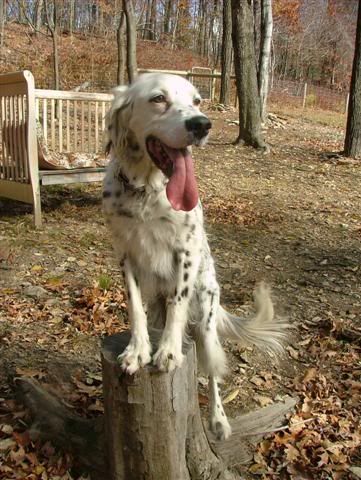I have rescued and owned English setters for over 5 years. I have had a dozen in my house, and known a hundred more personally.
As stated, Llewellins ARE English setters, but they are a specific bloodline. Sometimes the name Llewellin is used interchangeably to mean any field bred ES, but that is a bit misleading. ONLY dogs that are registered with FDSB as Llewellins are *actually* Llewellin setters, and they must have one of the original dogs in their bloodline for that privilege.
Llewellins are not physically that much different than any other field bred setter, but because their bloodline has been kept pure they do usually have a more consistent type, whereas other field setters can come in any shape and size, really. I've know 25 lb field setters and I've known 70 lb field setters, and all of these are okay, but Llewellin setters are expected to be more or less between 35 (low end female) to 60 (high end male) range.
There is no reason that you cannot have a field bred English setter as a pet; I've done it successfully with three, several fosters, and have worked with two rescues for this breed that have successful placements all the time. There are some members of the breed that are very "birdy" and drivey, and they need a job. Substituting Flyball and the like does not always work, some of them are just BRED for birds, and that's what they want to do. My George is absolute proof of this. The dog lives, breathes, and dreams of birds. No interest whatsoever in any other activity. He can run for hours and hours without stopping. Like many setters, he doesn't know how to turn off in the field and can and will work himself to exhaustion if I don't stay on top of him.
That being said, even most of the more driven field setters have a very defined "off" switch when in the house. They are wonderful with people, exceptionally friendly, and seem to understand that there is a time and a place for work. HOWEVER, if you do not exercise these dogs at all, they are more likely to take up activity in the house, usually pacing from window to window and worrying over toys. I have seen many dogs of this breed who were underexercised come into rescue with Canine Compulsive Disorder to some degree because their drive and energy was wasted or ignored.
If you are planning to exercise and train your puppy from the get-go, I can see no reason for you to NOT have this dog.

They *are* very soft dogs as someone mentioned but I don't see that as being a problem for most people. If you're used to GSDs or the like, you might not like a setter so much but otherwise, they're easy to work with.
Two of my friends have rescued Llewellins traced straight back to Dashing Bondhu, and related to "Hank" from the TV show "Hunting with Hank." They ended up in rescue because they were both deaf. Deafness is extremely common in English setters because of their white spotting gene (think of dalmatians) and so be prepared for unilateral or bilateral deafness, which manifests itself after the pup is a few weeks old. Many breeders have done well by not breeding dams that throw deaf pups but truthfully, it is relative to the lack of pigmentation that may appear inside their ears and that can happen with any piebald dog, regardless of family history. My Dover (who lacks pigment over most of his body) is deaf.
There are great setter mailing lists (Setters-L listserv is the biggest that I know of) and lots of great sites about Llewellin bloodlines specifically. Good luck! Welcome to setter madness










